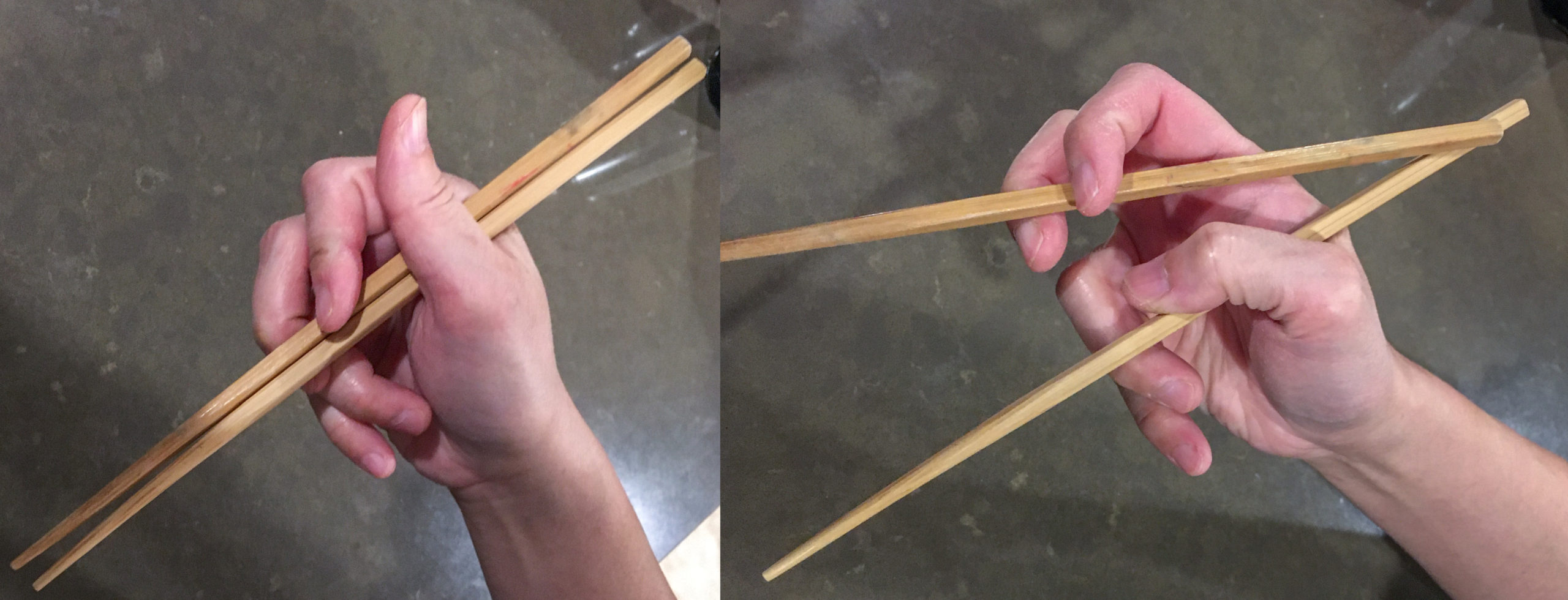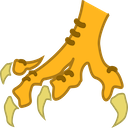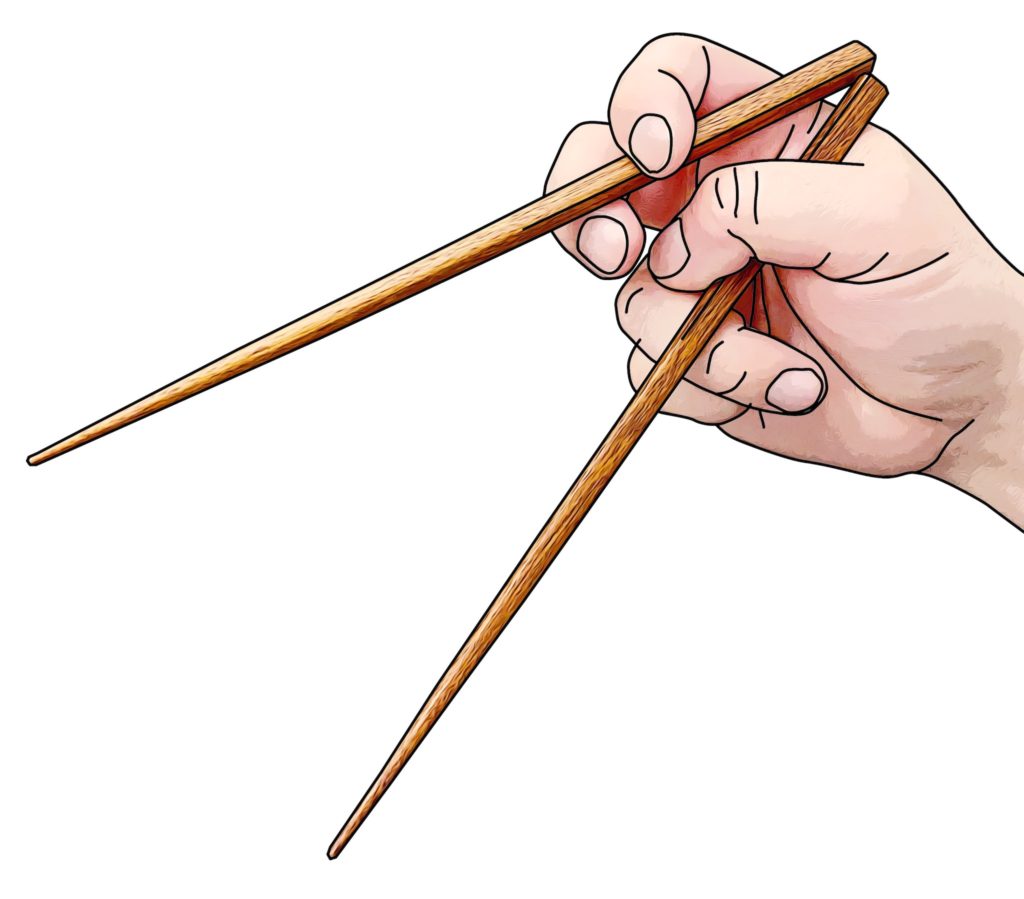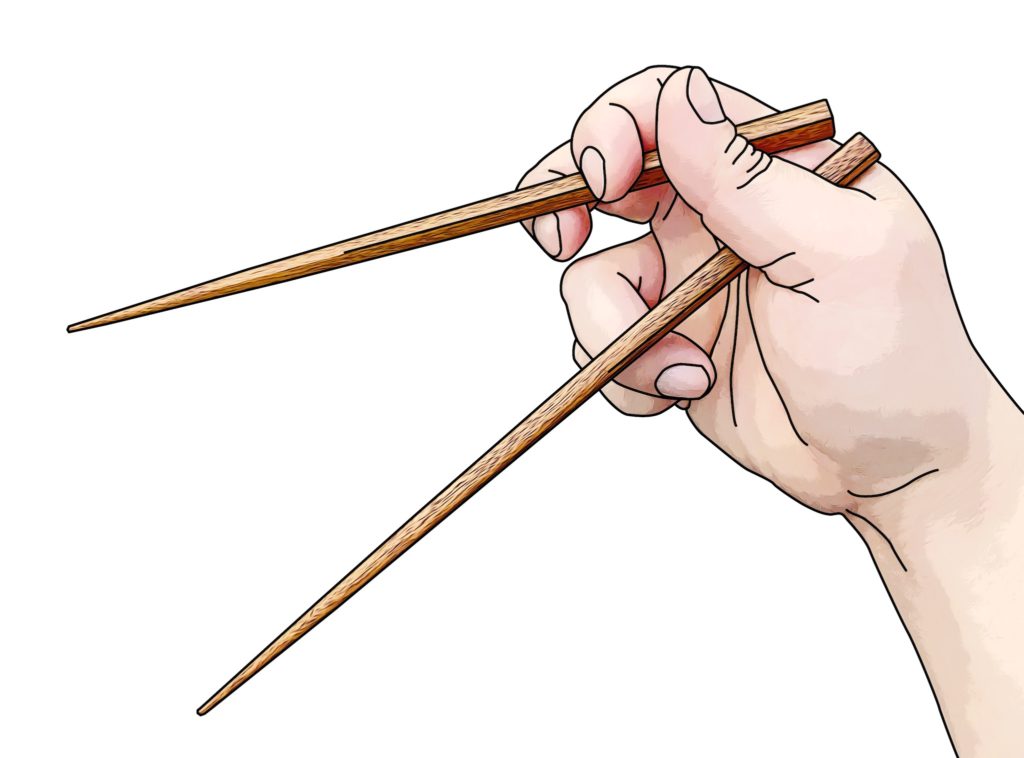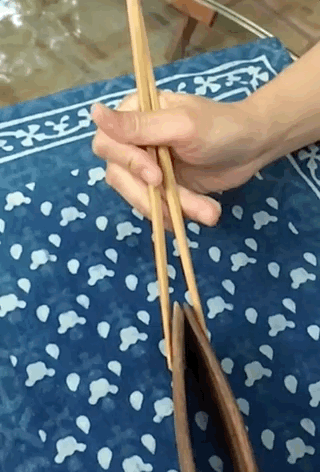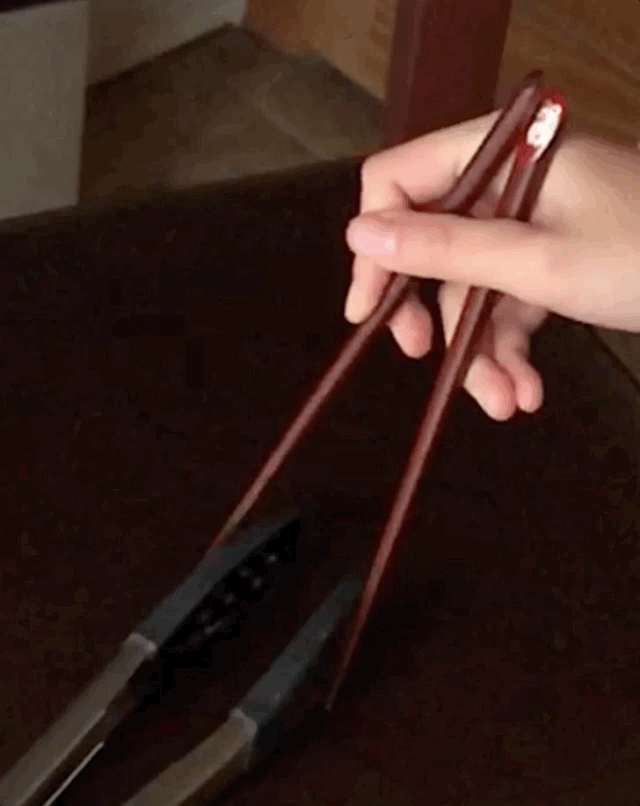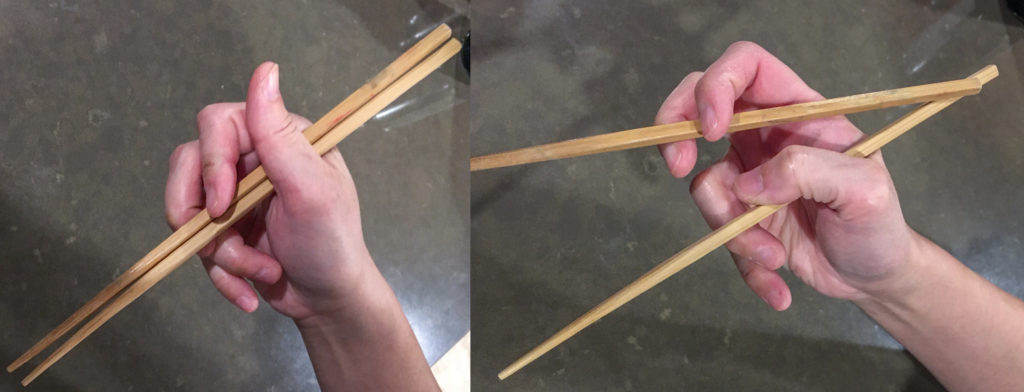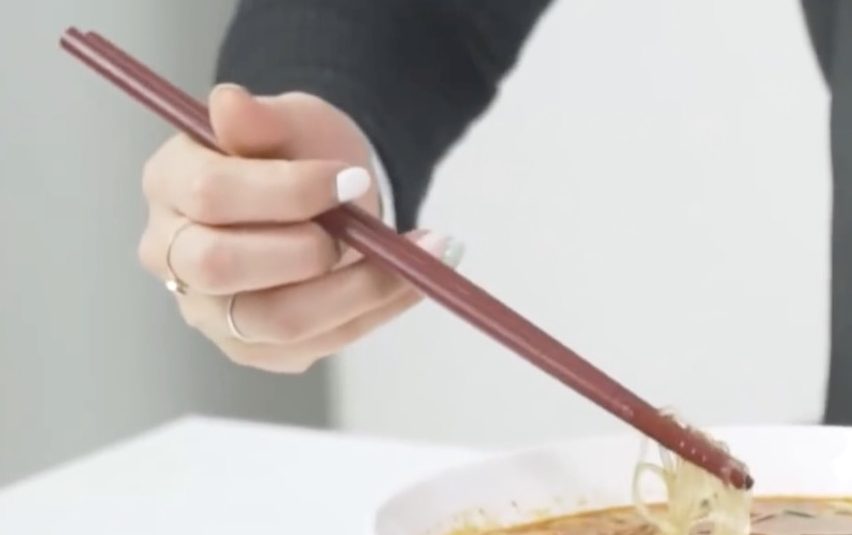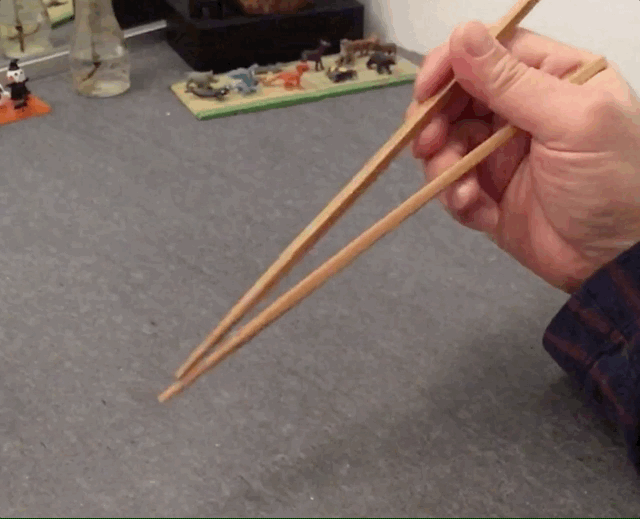Last Updated on 2021 年 08 月 21 日 by 編輯
The first time we observed the Chicken Claws grip in action at a restaurant, we were shocked. This grip looked alien and menacing at the same time. Someone at the table jokingly suggested “T-Rex Claws” as a name. Sadly, T-Rex sported only two claws in each forelimb. We settled on the chicken instead. *
After analysis of various slow-motion videos, we have come to realize that this alternative grip is closely-related to the Idling Thumb grip, despite drastic differences in looks. It may be hard to believe that this grip is only two steps away from the Standard grip, given the shocking open posture shown in the article image. But truth is, the only significant difference between this grip and the Standard grip is the unemployed thumb.
內容目錄
Unemployed thumb and touching rear ends
Study the two versions of the closed posture shown below. The Chicken Claws version is found on the left, and the Standard Grip version is found on the right. Recall that the closed posture captures the finger configuration for closing tips of the two chopsticks on some food item, and for applying compression forces on said item to securely hold it between tips. If one were to start with the standard grip version on the right, and relief the thumb of all duties involving the top chopstick, then fingers and chopsticks may look like the Chicken Claws version on the left.
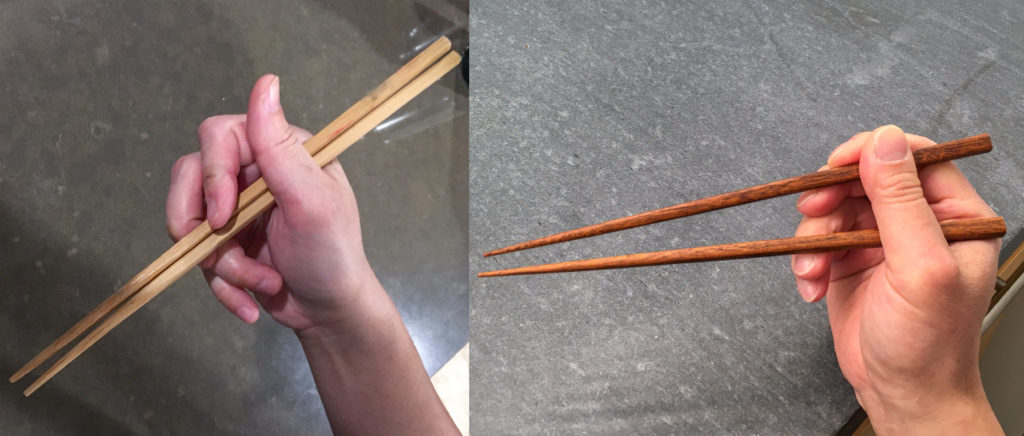
In the Chicken Claws grip on the left, nothing keeps the top chopstick separated from the bottom chopstick in the closed posture, unlike the standard grip version on the right where the tip of the thumb holds the top chopstick away from the bottom chopstick. Note how the tip of the thumb loiters around in the left image above. It does nothing useful at this posture. As a result, the index finger and the middle finger keep pushing the top chopstick down, until it hits the bottom chopstick, and rests on the bottom chopstick. Note how the rear ends of sticks in the left image touch each other, while the rears of sticks in the right image are kept away each other. Only the base segment of the thumb makes itself useful at this posture. It holds both top and bottom chopsticks in place, against the the purlicue on one side, and distal knuckles of the middle finger and the ring finger on the other side.
Chicken Claws vs. Idling Thumb
The Chicken Claws grip is compared to the Idling Thumb grip below. Both grips sport unemployed thumb tip at this closed posture. At the closed posture, the main difference between the two grips is the closeness of the top chopstick to the bottom chopstick. With the Chicken Claws grip on the left, the index finger bends inward at more than 90 degrees, in order to keep in contact with the top chopstick which have now dropped down to rest on the bottom chopstick. The index finger tends to continue pushing downward, forcing both chopsticks to angle further down, until the ring finer touches the palm. Note how the thumb points up, while the index finger points down.
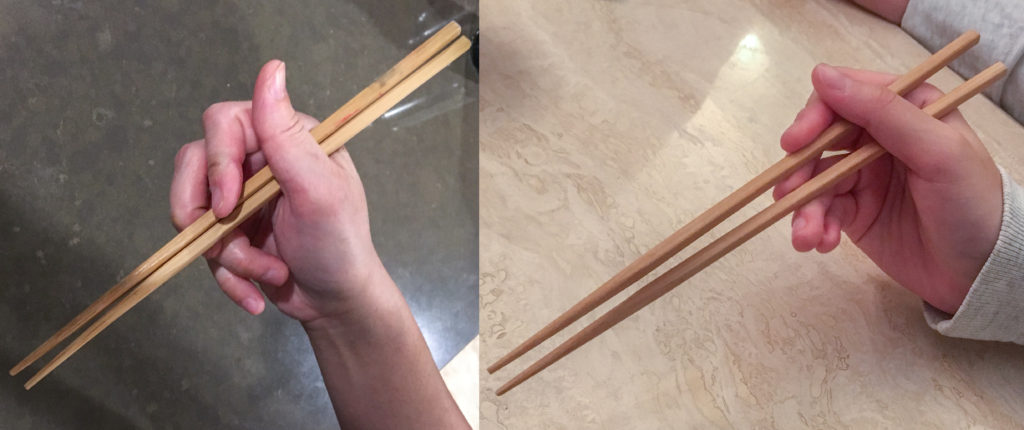
Extending tips of chopsticks with Chicken Claws
Now study the two versions of the open posture shown below. The Chicken Claws version is found on the left, and the Standard Grip version is found on the right. Recall that the open posture captures the finger configuration for extending tips of the two chopsticks apart, and for applying tension forces outward. If one were to start with the standard grip version on the right, and relief the thumb of all duties involving the top chopstick, then fingers and chopsticks may look like the Chicken Claws version on the left.
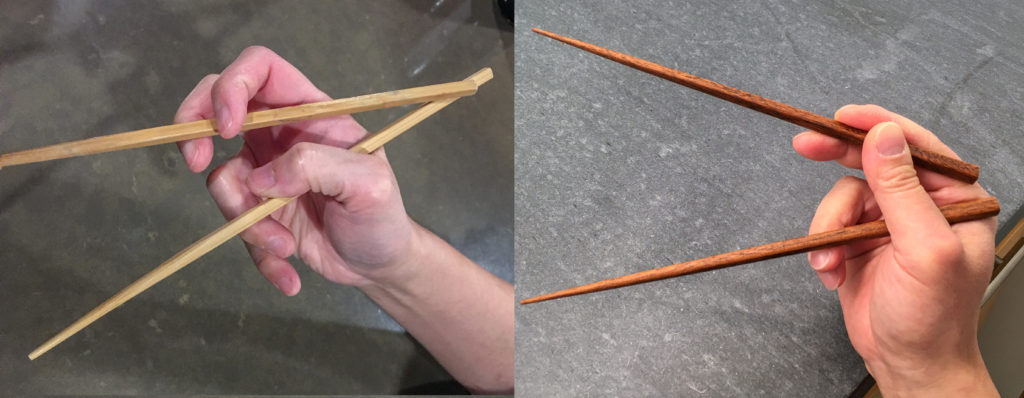
To extend the two chopsticks apart, something has to separate them from their former closed posture configuration where they abutted each other. Since the thumb has abdicated all responsibilities involving the top chopstick, the mandate then falls on the index finger and the middle finger alone to move the top chopstick. These two fingers now must hook onto the top chopstick, gain good purchase, and then attempt to snatch it away, all by themselves.
The unemployed thumb finds new purpose in life. It bends inward to help keep the bottom chopstick in place. This configuration of fingers look like a chicken feet with its menacing claws. However, the thumb does not always pry open the bottom chopstick. Sometimes it lingers uselessly on the top chopstick, as can be observed in the second half of the following video.
Persistent Chicken Claws vs. capitulating Idling Thumb
The Chicken Claws grip is compared to the Idling Thumb grip below. In both cases, the thumb isn’t helping the top chopstick, despite the deceptive look of the Idling Thumb version on the right. These two grips are quite similar, except that the Chicken Claws grip on the left is far more aggressive in attempting to move chopsticks. Thus, the index and middle claws hook and lift the top chopstick, and the thumb bends to give more leverage to the bottom chopstick. The mellower Idling Thumb grip on the right simply gives up when it tries but fails to move the top chopstick, as shown by video clips in the Idling Thumb grip article.
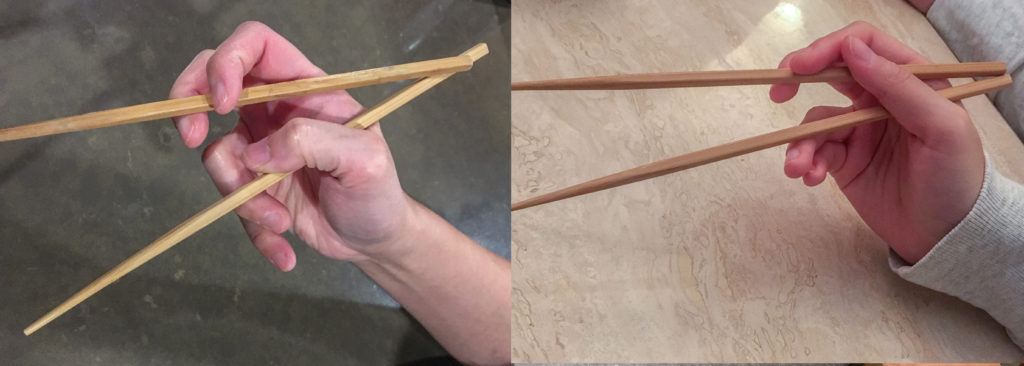
Closing salad tongs
At the open posture, the thumb may be bent as shown above, or extended straight as it usually is at the closed posture. The choice of the thumb pose depends on whether the two chopsticks are being used to push outward against obstacles. If no obstacles are present, and the hand is just separating tips of chopsticks against the air, then the thumb may remain extended straight throughout the alternating motion. Because the thumb isn’t helping to secure the bottom and separate it from the top chopstick, the two sticks end up forming a cross when index and middle fingers snatch the top chopstick upward. This is shown below in a slow-motion capture of a user closing salad tongs using a pair of chopsticks. An equivalent video capture of the Idling Thumb grip is shown on the right for comparison. In general, the Chicken Claws grip generates a much stronger compression force than the Idling Thumb grip.
Prying open salad tongs
On the other hand, if the user needs to exert some outward extension force with the two chopsticks, then the thumb will need to bend inward to hold the bottom chopstick, as previous discussed. This is shown below in a slow-motion capture of a user opening salad tongs using a pair of chopsticks. Again, an equivalent video capture of the Idling Thumb grip is shown on the right for comparison. In general, the Chicken Claws grip generates a much stronger extension force than the Idling Thumb grip. Users of the Idling Thumb grip are usually unable to exert extension forces.
Chicken Claws vs. Standard Grip
Chicken Claws is clearly a variant of Idling Thumb. But it is also closely related to Standard grip. It is hard to say which of Chicken Claws and Idling Thumb is closer to Standard Grip.
The Idling Thumb grip is closer to the Standard Grip in look. But the Chicken Claws grip is closer to Standard grip in strength. The Chicken Claws video below clearly shows that it makes good use of the distal knuckles of the middle finger and the ring finger, to gain good purchase. This is one area that Idling Thumb forgoes.
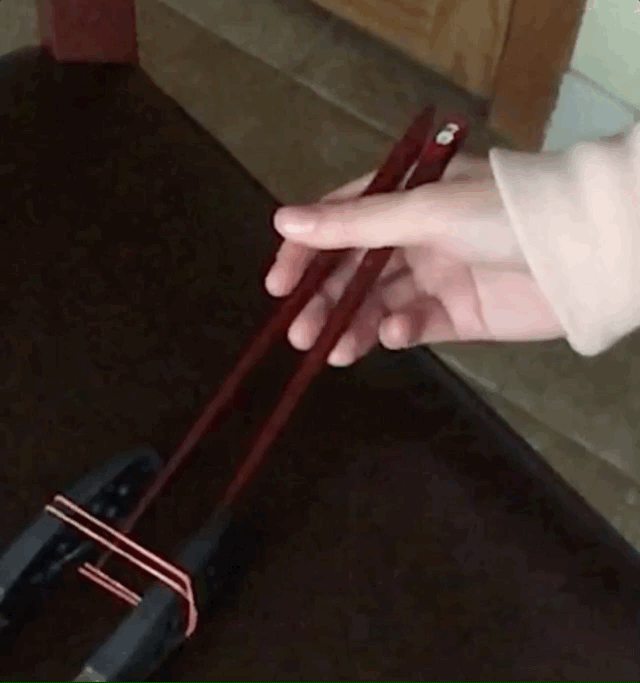
In Chicken Claws, the top chopstick is sandwiched between the tip of the index finger and the distal knuckle of the middle finger, when exerting compression forces, as well as when exerting extension forces. The same cannot be said of the Idling Thumb grip. Even the unusual hooking posture of the index finger and the middle finger in the above clip is almost correct. It’s a severely-disadvantaged version of the air quote gesture from the stand grip, due to the lack of cooperation from the thumb.
Varied thumb and index finger placements
Following are all pictures of the same user wielding the Chicken Claws grip. All three pictures show the closed posture. Since the thumb is unemployed, it can be placed anywhere. The thumb may be extended flat as shown on the left, or it may be slightly curved as shown on the right. It doesn’t matter.

The pose of the index finger is also varied, even though it does play a role in the manipulation of the top chopstick.
When extending chopsticks apart, the thumb may linger on the top chopstick, and helping with the movement of either stick. Or the thumb may move to the bottom chopstick to help pry it open.
Additional pictures
Key postures of this grip are shown below. From left to right, they are: 1) Max Open posture, 2) Open posture, and 3) Abutting posture.

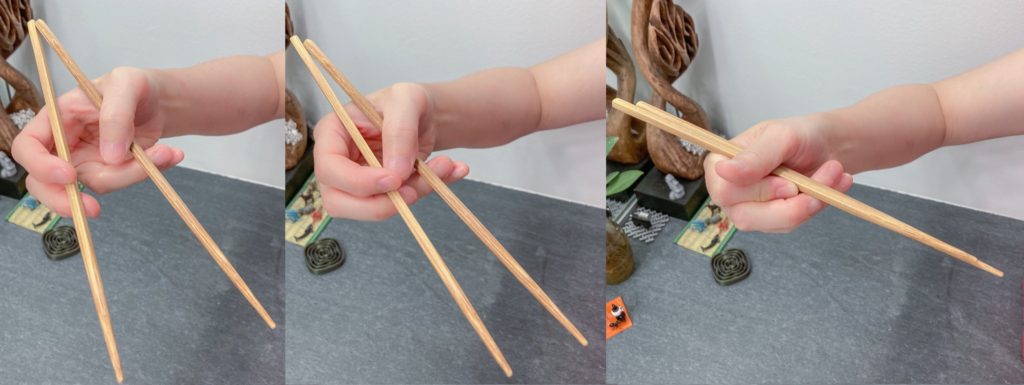
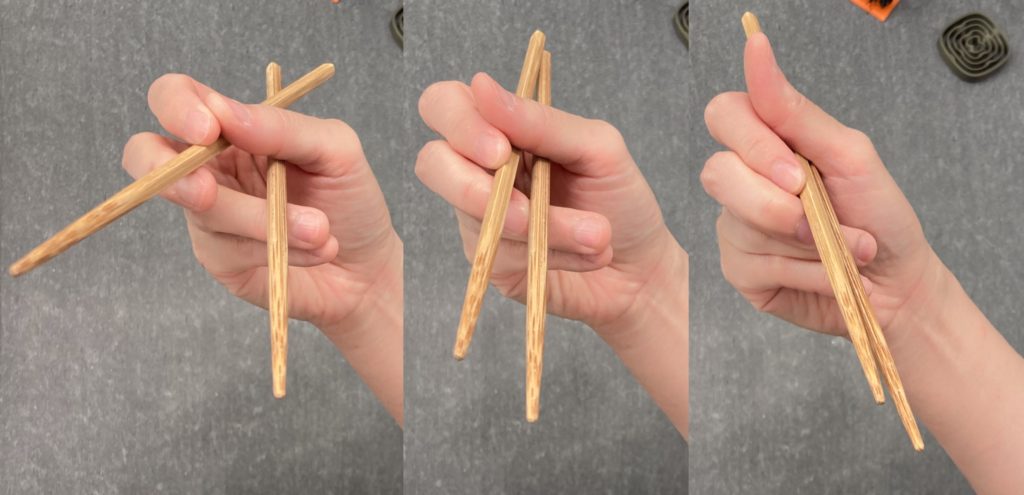

Dino Claws and Dangling Stick
(2020-02) We found an alternative grip worthy of the name Dino Claws, after all. It turns out to be a derived form of Chicken Claws. Check it out here: Dino Claws. Also check out another derived form of Chicken Claws, the Dangling Stick grip. All of them can be found on the Family Tree of alternative grips.
Lateral grips, and Lateral Chick
(2021-05) It took us two years of data collection, before we discovered the largest chopstick grip family, the Lateral chopstick grips. And it turns out that Chicken Claws is a remote relative of these Lateral grips.
Take a look at the following member of the Lateral grip family. It is named Lateral Chick, because it is a bridge between Chicken Claws and a subfamily of Lateral called Lateral Classic.
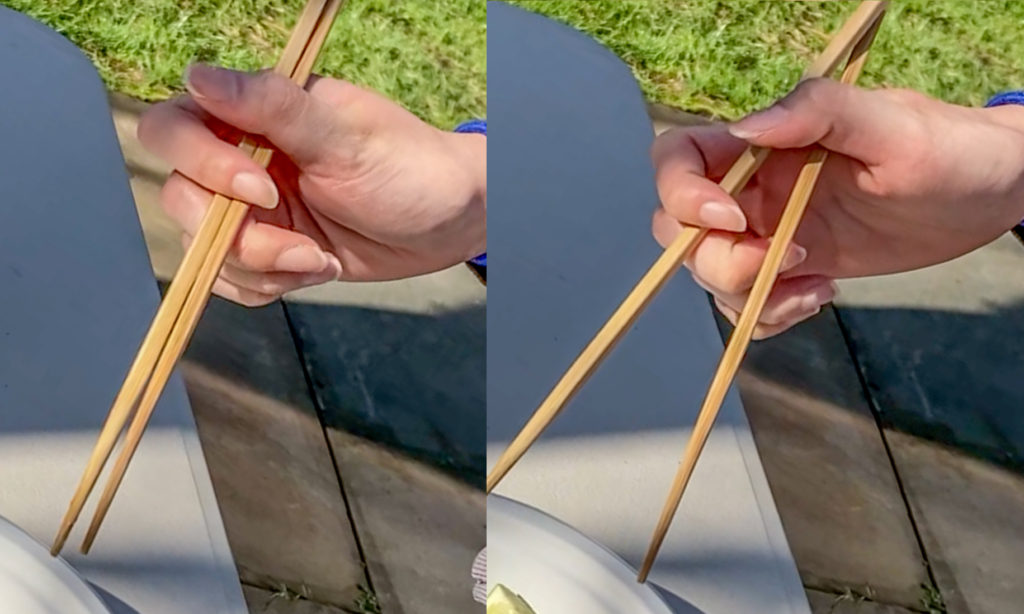
Now, compare the above to Chicken Claws, shown below. The resemblance is uncanny, especially at the Abutting posture shown to the left.
But one should also note subtle differences that make Chicken Claws deserve its own grip name, outside of the Lateral family. Look at the Max open postures shown on the right above, of Lateral Chick, and of Chicken Claws. In Lateral Chick, the bottom chopstick always rests on the middle finger, even in the Max open posture. In Chicken Claws, the bottom chopstick rests on the ring finger instead.
Chicken Claws is thus fundamentally different from all Lateral grips. In its Open posture and Max open posture, it morphs from a Lateral grip to a completely different beast. Its middle finger no longer makes contact with the bottom chopstick. The tip segment of the thumb is used to pry open the bottom chopstick. More importantly, the index finger and the middle finger sandwich the top chopstick at the Open posture and Max open posture, moving it upward and away from the bottom chopstick. This feature breeds its own subfamily of chopstick grips, including Dangling Stick and Muppet Grip. Cementing its status as a founder grip of its own.
Similar hybrid: Double Hook
(2021-05) In May 2021 we analyzed an excellent episode on chopsticks and chopsticking by World Friends YouTube channel. We published a writeup of this review in YouTube episode on chopsticking from WorldFriends.
Of relevance to Chicken Claws is the hybrid grip that Jane uses. Jane extends chopsticks apart with Idling Thumb, but closes them against food items with Lateral compression. This hybrid approach is also seen in the Lateral Turncoat grip, where Turncoat extension is used in combination with Lateral compression. It is also similar to how Chicken Claws adopts a Lateral compression, and an Idling Thumb-like extension. But Chicken Claws, of course, takes it to the next level, with its super-wide chopstick extension range enabled by its special use of the thumb at the Max open posture.
Following images show the Closed posture (left) and the Open posture (right) from one part of the video.
Update 2021-08: we have now named this grip Double Hook. It is a variant of Hook n Clamp.
Following pictures compare the extension mechanism of Chicken Claws (on the left) to Double Hook (center), and to Idling Thumb (on the right). The index finger and middle finger configuration of Double Hook resembles that of Chicken Claws (left). But the thumb pose of Double Hook resembles that of Idling Thumb (right).
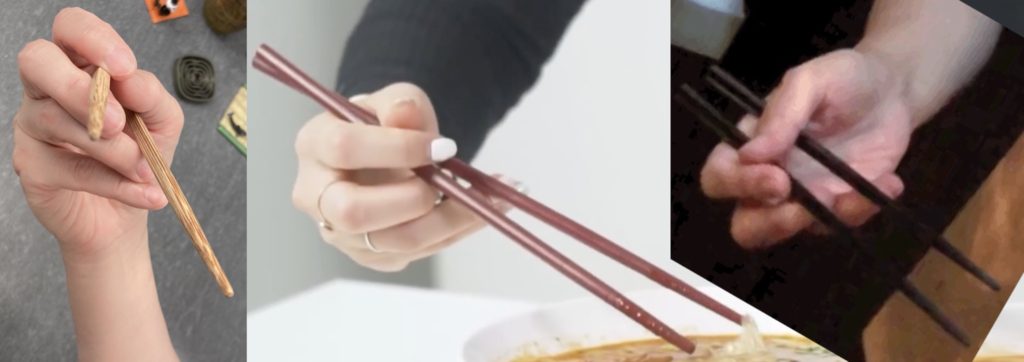
Following pictures compare the compression mechanism of Chicken Claws (on the left) to Double Hook (center), and to Idling Thumb (on the right). The primary difference is in where the thumb interacts with the top chopstick. In Chicken Claws (left) and Double Hook, the thumb base holds the top chopstick, and as a result, rear ends of chopsticks abut each other. In Idling Thumb (right), the thumb joint holds the top chopstick, thus giving rear ends enough distance from each other.
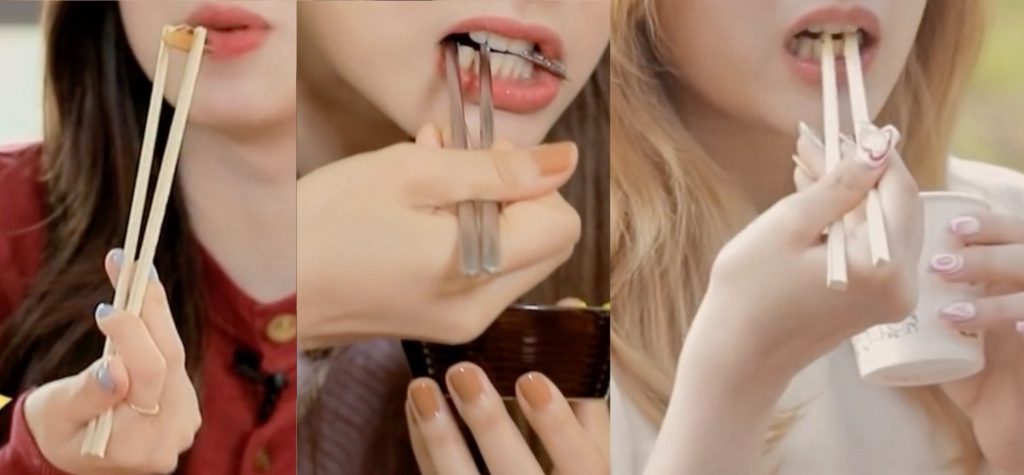
Dahyun’s Chicken Claws grip
In August 2021 we analyzed chopstick grips of all nine members of TWICE. Dahyun primarily wields Idling Thumb. But she seamlessly transitions from it to closely-related grips such as Chicken Claws and Double Hook as needed.
Dahyun switch from Idling Thumb to Chicken Claws, for pinching and picking up food, at times. This grip clutches the two chopsticks using all fingers, the side and the base of the thumb, plus the purlicue. It is essentially the same the compression technique of all Lateral grips. The telltale sign is again the rear end of chopsticks during compression. These abut each other, and serve as a pivot for the two chopsticks, as the index finger and the thumb base clutch them shot.
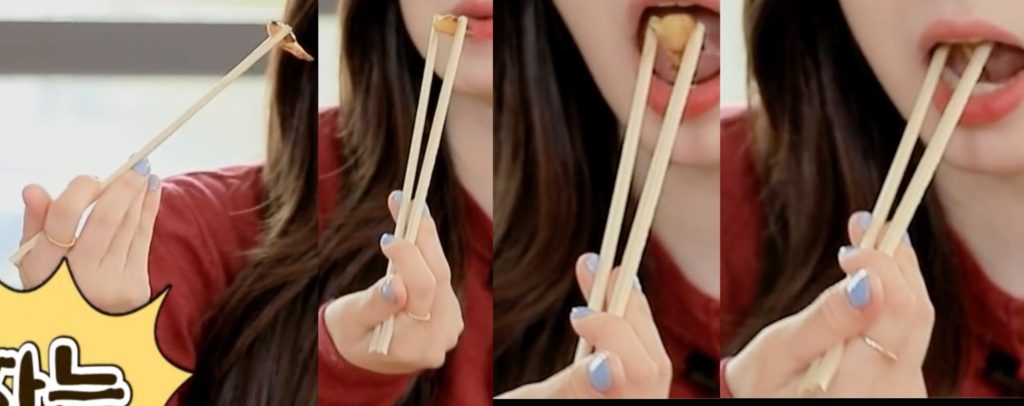
Learn new grips
Before we close, let’s remind reader why a fully-employed thumb is a good thing. Observe the undisadvantaged air quote gesture from the standard grip below.
Users of this alternative grip can add Standard Grip to their chopsticking repertoire, by simply learning to better make use of the tip segment of the thumb, to help twirl the top chopstick. Learn to twirl chopsticks, if you are interested.
Taiwanese: 鷄脚爪
This grip is known as 鷄脚爪 (Ke-kha-jiáu) in Taiwanese.
